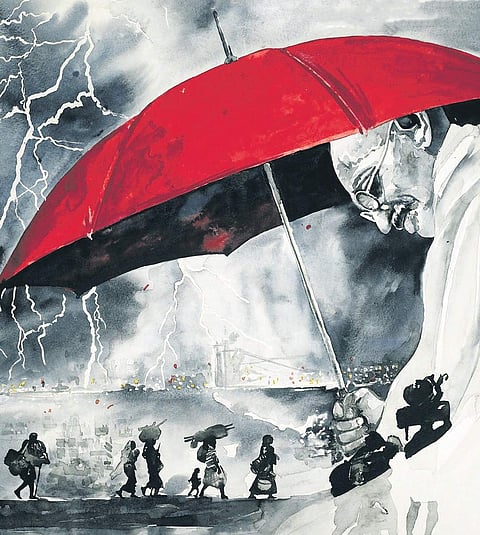

HYDERABAD: This year, we are celebrating the 150th birth anniversary of the Father of the Nation, Mahatma Gandhi. Irish poet and haiku master Gabriel Rosenstock, along with renowned Kashmiri artist Masood Hussain, have launched ‘Walk with Gandhi’, a kaleidoscope of events, real and imagined, in the life of Mahatma Gandhi. With a foreword by noted historian and writer Ramachandra Guha, the book is set to hit the shelves on October 5. We showcase a few selected excerpts
HYDERABAD: One of the great events in India’s freedom struggle was the march to Dandi, a coastal town in the Mahatma’s native state, Gujarat. There he and his followers gathered sea-salt, a commodity which was taxed by the British administration. (India under British rule was known as the Raj. Direct rule lasted from 1859 to 1947, the year before Gandhi’s death). Gandhi marched from his ashram – a spiritual retreat – on March 12, 1930, and reached the shores of the Arabian Sea on April 5 where he and his followers helped themselves to some salt. It was a gesture that shook the Empire. Gandhi and his followers had walked over 240 miles. Women and men were viciously clubbed when they reached Dandi; yet none of them offered any resistance as they fell, bleeding, to the ground.
The Mahatma believed that ahimsa, non-violence, was the key to emancipation, to personal and political freedom. Civil disobedience represented a moral force that would shame the British Empire in the eyes of the civilised world. Civil disobedience inspired other leaders, civil rights leaders in America and Northern Ireland, for instance, as well as many student groups such as OTPOR in Belgrade. It is a tactic still used today by many people who campaign for various important issues, such as maintaining biodiversity, creating a clean and safe environment, advocating for peace, social justice and transparency and securing the survival of minority languages.
It wasn’t a man called Godse who killed Gandhi. No, no, no! Not at all. According to a wise Indian philosopher, Jiddu Krishnamurti, you killed him. I’m afraid so. Yes, you! You held the Beretta 9mm pistol in your hand and shot him three times. I killed him as well. We all killed him. As long as we see ourselves as divided, one from the other, we are potentially very dangerous – deadly in fact. In the course of a public talk in Mumbai, shortly after Gandhiji’s death, Krishnamurti tried to get this point across, reminding us of the fractured nature of humanity, our blindness to the oneness and sacredness of us all. If you want a name for this philosophy, it’s Advaita or Non-duality. He said, “You are either a Hindu, a Parsee, a Buddhist, or a Mussulman – you know, the whole rot of identified division, isolation. So… you are responsible, aren’t you? You are the real cause of this murder.” This is classic Indian philosophy and it’s what Gandhi himself believed, seeing the Self in all and all in the Self.
(Excerpted with permission from Gabriel Rosenstock)